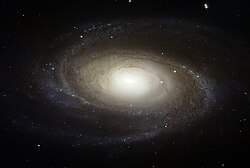Bulge


Als Bulge (engl. bulge, „Ausbuchtung“, „Aufwölbung“) bezeichnet man in der Astronomie den dichten Zentralbereich einer Spiralgalaxie. Der Bulge hebt sich deutlich von der übrigen Galaxie ab. Zum einen erscheint er durch seine hohe Dichte sehr viel heller, zum anderen wölbt er sich in der Regel weit über die Scheibenebene hinaus. Bei sehr weit entfernten Galaxien ist der Bulge häufig das Einzige, was von der Galaxie zu sehen ist. Ein Bulge ähnelt einer elliptischen Galaxie.
Im Innern des Bulges sitzt neueren Forschungen zufolge häufig ein Schwarzes Loch, so auch im Zentrum unserer Milchstraße. Das Verhältnis zwischen der Masse des Bulges und derjenigen des Schwarzen Lochs (mit anderen Worten „der Massenanteil des Bulges, der im Schwarzen Loch steckt“) ist mit 0,2 % (nach Ho, 1999[1] und Wandel, 1999[2]) bzw. 0,6 % (nach Kormendy und Richstone, 1995[3]) bei unterschiedlichen Galaxien konstant. Die Größen der Prozentangaben sind in der Forschung umstritten.[4][5]
Siehe auch
- Pseudo-Bulge
- Halo (Astronomie)
Einzelnachweise
- ↑ Luis C. Ho: Supermassive Black Holes in Galactic Nuclei. In: S. K. Chakrabarti (Hrsg.): Observational Evidence for the Black Holes in the Universe. 1999, S. 157.
- ↑ A. Wandel: The Black Hole–to–Bulge Mass Relation in Active Galactic Nuclei. In: The Astrophysical Journal. 519, S. L39–L42, 1999, doi:10.1086/312106.
- ↑ John Kormendy, Douglas Richstone: Inward Bound – The Search for Supermassive Black Holes in Galactic Nuclei. In: Annual Review of Astronomy and Astrophysics. 33, 195, S. 581–624, doi:10.1146/annurev.aa.33.090195.003053, bibcode:1995ARA&A..33..581K.
- ↑ Max Camenzind: Compact objects in Astrophysics. White Dwarfs, Neutron Stars and Black Holes. Springer, Berlin 2007, ISBN 978-3-540-25770-7, S. 465.
- ↑ Andreas Eckart, Rainer Schödel, Christian Michael Straubmeier: The black hole at the center of the Milky Way. Imperial College Press, London 2005, ISBN 1-86094-567-8, S. 218.
Auf dieser Seite verwendete Medien
Autor/Urheber: ESO, Lizenz: CC BY 3.0
The galaxy pictured here is NGC 4565, which for obvious reasons is also called the Needle Galaxy. First spotted in 1785 by Uranus' discoverer, Sir William Herschel (1738-1822), this is one of the most famous example of an edge-on spiral galaxy and is located some 30 million light-years away in the constellation Coma Berenices (Berenice's Hair). It displays a bright yellowish central bulge that juts out above most impressive dust lanes.
Because it is relatively close (it is only 12 times farther away than Messier 31, the Andromeda galaxy, which is the major galaxy closest to us) and relatively large (roughly one third larger than the Milky Way), it does not fit entirely into the field of view of the FORS instrument (about 7 x 7 arcmin2).
Many background galaxies are also visible in this FORS image, giving full meaning to their nickname of "island universes".The spiral galaxy Messier 81 is tilted at an oblique angle on to our line of sight, giving a "birds-eye view" of the spiral structure. The galaxy is similar to our Milky Way, but our favorable view provides a better picture of the typical architecture of spiral galaxies. Though the galaxy is 11.6 million light-years away, NASA Hubble Space Telescope's view is so sharp that it can resolve individual stars, along with open star clusters, globular star clusters, and even glowing regions of fluorescent gas.

